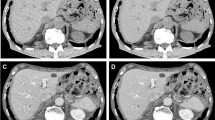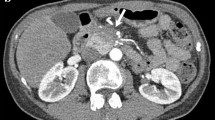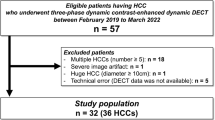Abstract
Purpose
To evaluate the image quality of ultra-high-resolution CT (U-HRCT) images reconstructed using an improved deep-learning-reconstruction (DLR) method. Additionally, we assessed the utility of U-HRCT in visualizing gastric wall structure, detecting gastric cancer, and determining the depth of invasion.
Methods
Forty-six patients with resected gastric cancer who underwent preoperative contrast-enhanced U-HRCT were included. The image quality of U-HRCT reconstructed using three different methods (standard DLR [AiCE], improved DLR—AiCE-Body Sharp [improved AiCE-BS], and hybrid-IR [AIDR3D]) was compared. Visualization of the gastric wall’s three-layered structure in four regions and the visibility of gastric cancers were compared between U-HRCT and conventional HRCT (C-HRCT). The diagnostic ability of U-HRCT with the improved AiCE-BS for determining the depth of invasion of gastric cancers was assessed using postoperative pathology specimens.
Results
The mean noise level of U-HRCT with the improved AiCE-BS was significantly lower than that of the other two methods (p < 0.001). The overall image quality scores of the improved AiCE-BS images were significantly higher (p < 0.001). U-HRCT demonstrated significantly better conspicuity scores for the three-layered structure of the gastric wall than C-HRCT in all regions (p < 0.001). In addition, U-HRCT was found to have superior visibility of gastric cancer in comparison to C-HRCT (p < 0.001). The correct diagnostic rates for determining the depth of invasion of gastric cancer using C-HRCT and U-HRCT were 80%.
Conclusions
U-HRCT reconstructed with the improved AiCE-BS provides clearer visualization of the three-layered gastric wall structure than other reconstruction methods. It is also valuable for detecting gastric cancer and assessing the depth of invasion.







Similar content being viewed by others
References
Sitarz R, Skierucha M, Mielko J, Offerhaus GJA, Maciejewski R, Polkowski WP (2018) Gastric cancer: epidemiology, prevention, classification, and treatment. Cancer Manag Res. 10:239-248. https://doi.org/10.2147/cmar.s149619
Hallinan JT, Venkatesh SK (2013) Gastric carcinoma: imaging diagnosis, staging and assessment of treatment response. Cancer Imaging. 13(2):212-227. https://doi.org/10.1102/1470-7330.2013.0023
Zytoon AA, El-Atfey SIB, Hassanein SA-H (2020) Diagnosis of gastric cancer by MDCT gastrography: diagnostic characteristics and management potential. Egyptian Journal of Radiology and Nuclear Medicine. 51(1):30. https://doi.org/10.1186/s43055-020-0148-y
Shimizu K, Ito K, Matsunaga N, Shimizu A, Kawakami Y (2005) Diagnosis of gastric cancer with MDCT using the water-filling method and multiplanar reconstruction: CT-histologic correlation. AJR Am J Roentgenol. 185(5):1152-1158. https://doi.org/10.2214/ajr.04.0651
Oostveen LJ, Boedeker KL, Brink M, Prokop M, de Lange F, Sechopoulos I (2020) Physical evaluation of an ultra-high-resolution CT scanner. Eur Radiol. 30(5):2552-2560. https://doi.org/10.1007/s00330-019-06635-5
Tsubamoto M, Hata A, Yanagawa M, Honda O, Miyata T, Yoshida Y, Nakayama A, Kikuchi N, Uranishi A, Tsukagoshi S, Watanabe Y, Tomiyama N (2020) Ultra high-resolution computed tomography with 1024-matrix: Comparison with 512-matrix for the evaluation of pulmonary nodules. Eur J Radiol. 128:109033. https://doi.org/10.1016/j.ejrad.2020.109033
Hata A, Yanagawa M, Honda O, Kikuchi N, Miyata T, Tsukagoshi S, Uranishi A, Tomiyama N (2018) Effect of Matrix Size on the Image Quality of Ultra-high-resolution CT of the Lung: Comparison of 512 × 512, 1024 × 1024, and 2048 × 2048. Acad Radiol. 25(7):869-876. https://doi.org/10.1016/j.acra.2017.11.017
Bennink E, Oosterbroek J, Horsch AD, Dankbaar JW, Velthuis BK, Viergever MA, de Jong HW (2015) Influence of Thin Slice Reconstruction on CT Brain Perfusion Analysis. PLoS One. 10(9):e0137766. https://doi.org/10.1371/journal.pone.0137766
Liu X, Chen L, Qi W, Jiang Y, Liu Y, Zhang M, Hong N (2017) Thin-slice brain CT with iterative model reconstruction algorithm for small lacunar lesions detection: Image quality and diagnostic accuracy evaluation. Medicine (Baltimore). 96(51):e9412. https://doi.org/10.1097/md.0000000000009412
Tao S, Rajendran K, Zhou W, Fletcher JG, McCollough CH, Leng S (2020) Noise reduction in CT image using prior knowledge aware iterative denoising. Phys Med Biol. 65(22). https://doi.org/10.1088/1361-6560/abc231
Leon S, Olguin E, Schaeffer C, Olguin C, Verma N, Mohammed TL, Grajo J, Arreola M (2021) Comparison of CT image quality between the AIDR 3D and FIRST iterative reconstruction algorithms: an assessment based on phantom measurements and clinical images. Phys Med Biol. 66(12). https://doi.org/10.1088/1361-6560/ac0391
Greffier J, Dabli D, Frandon J, Hamard A, Belaouni A, Akessoul P, Fuamba Y, Le Roy J, Guiu B, Beregi JP (2021) Comparison of two versions of a deep learning image reconstruction algorithm on CT image quality and dose reduction: A phantom study. Med Phys. 48(10):5743-5755. https://doi.org/10.1002/mp.15180
Higaki T, Nakamura Y, Zhou J, Yu Z, Nemoto T, Tatsugami F, Awai K (2020) Deep Learning Reconstruction at CT: Phantom Study of the Image Characteristics. Acad Radiol. 27(1):82-87. https://doi.org/10.1016/j.acra.2019.09.008
Sakai Y, Hida T, Matsuura Y, Kamitani T, Onizuka Y, Shirasaka T, Kato T, Ishigami K (2023) Impact of a new deep-learning-based reconstruction algorithm on image quality in ultra-high-resolution CT: clinical observational and phantom studies. Br J Radiol. 96(1141):20220731. https://doi.org/10.1259/bjr.20220731
Ge Y, Su T, Zhu J, Deng X, Zhang Q, Chen J, Hu Z, Zheng H, Liang D (2020) ADAPTIVE-NET: deep computed tomography reconstruction network with analytical domain transformation knowledge. Quant Imaging Med Surg. 10(2):415-427. https://doi.org/10.21037/qims.2019.12.12
Onoda H, Tanabe M, Higashi M, Kawano Y, Ihara K, Miyoshi K, Ito K (2022) Assessment of gastric wall structure using ultra-high-resolution computed tomography. Eur J Radiol. 146:110067. https://doi.org/10.1016/j.ejrad.2021.110067
Funding
No funding was received for conducting this study.
Author information
Authors and Affiliations
Corresponding author
Ethics declarations
Conflicts of interest
The authors have no conflicts of interest or disclosures to declare.
Ethical approval
This retrospective study was approved by the institutional review board, and informed consent was waived.
Additional information
Publisher's Note
Springer Nature remains neutral with regard to jurisdictional claims in published maps and institutional affiliations.
Rights and permissions
Springer Nature or its licensor (e.g. a society or other partner) holds exclusive rights to this article under a publishing agreement with the author(s) or other rightsholder(s); author self-archiving of the accepted manuscript version of this article is solely governed by the terms of such publishing agreement and applicable law.
About this article
Cite this article
Tanabe, M., Tanabe, M., Onoda, H. et al. Ultra-high resolution computed tomography with deep-learning-reconstruction: diagnostic ability in the assessment of gastric cancer and the depth of invasion. Abdom Radiol (2024). https://doi.org/10.1007/s00261-024-04363-z
Received:
Revised:
Accepted:
Published:
DOI: https://doi.org/10.1007/s00261-024-04363-z




